BIOGRAPHICAL NOTES ON
LOUIS XVI
1754-1793
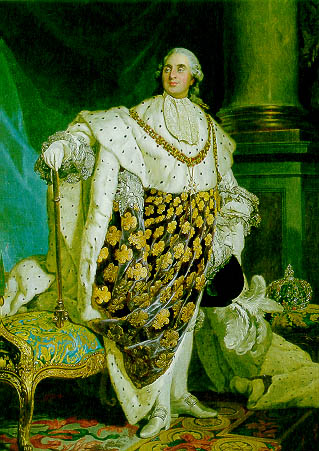
Painting of Louis XVI
by Duplessis, mid 1780's
www.mtholyoke.edu/courses/rschwart/ hist255/kat_anna/louis.html
MARIE-ANTOINETTE Louis XVI died on the guillotine, in 1793, So where did it start? We can look at his beginning on the throne. The new king and queen exclaimed, Louis XVI (1754-1793) was not only young, he was unprepared to govern; educational efforts had focused on his elder brother, who died prematurely. The new monarch's natural qualities-piety, loyalty, sense of duty, curiosity and interest in technology-were not the ones required of a king. And his lack of personal presence was in sharp contrast to the majesty of his predecessors! His love for his people (who reciprocated it) could not compensate for his total lack of decisiveness, which proved fatal for the monarchy.
His Great-Grand-Father LOUIS XIV Louis XIV also commissioned Le Brun to build Three Queens resided in Versailles:
Louis XIV's grandson, Louis XV, also reigned long years: Louis XV's 59-year reign (1715�1774) was marked by great prosperity thanks to quiet borders, domestic peace, demographic growth, and technical progress. A taste for elegance and luxurious refinement within a convivial atmosphere took hold in France and then spread to the rest of Europe. Versailles set the tone,
LOUIS XV's Royal Family By the time he was 27, Louis had already fathered ten royal children, seven of whom survived � the Dauphin (father of the future Louis XVI) and six royal princesses, who were collectively known as 'Mesdames'.
Ange-Jacques Gabriel
MARIE-ANTOINETTE DE HAPSBOURG LORRAINE Even when you know nothing about History, it is a fact that most people around the world DO know about Marie Antoinette, for being THE French Queen who literally "lost her head" in 1793, during the FRENCH REVOLUTION.
Marie-Antoinette is still loved by many and is well remembered for her beauty, simplicity and extravagance. Marie-Antoinette of Hapsburg-Lorraine, born in 1755, was the daughter of the all-powerful Maria Theresa who reigned in Vienna.
LOUIS XVI and MARIE-ANTOINETTE As soon as she arrived at the court of France, Marie-Antoinette occupied the Queen's Suite where she had to observe the obligations imposed on a French queen-levee, dressing, audiences, public repasts, and so on. A queen's primary obligation, of course, was to provide a dynastic heir. The people of France resented waiting so long for an heir, eleven years for the birth of the first child,
Marie-Antoinette has been criticized for her excessive penchant for festivities, yet it was Louis XVI who officially charged her with entertaining the court. Her efforts made a real impact: grand balls were held once again, the number of theatres grew, and there was a radical change in both musical and theatrical repertoires (which welcomed foreigners-too many foreigners!). The queen, resolutely modern and open to change, favoured composers like Gluck, Piccini, Salieri, Sacchini, and others. Hoping to recreate at Versailles her earlier lifestyle at Sch�nbrunn-more relaxed, among family and friends-Marie-Antoinette tended to forget that she was queen of France. She retreated too often with her entourage to her cabinets, the Petit Trianon, or the Hamlet. She even dared to put on Beaumarchais's "The Marriage of Figaro", a play censored by the king, in her own little theatre. By surrounding herself with a few favourites, Marie-Antoinette cut herself off from the court, whose backing she would lack during the crucial moments of the French Revolution The Queen Marie-Antoinette's Bedchamber Marie-Antoinette found this terribly old-fashioned, and decided to replace all the furnishings, notably commissioning silk hangings woven in patterns of lilacs and peacock feathers, garnishing the alcove and the enormous four-poster bed (restored in 1976). The people of France nicknamed her "Madame Deficit" because of her love of extravagance. She became the leader of fashion in France, soon after her marriage to Louis and her taste added to France's already burdened treasury.
Marie-Antoinette turned to meddling in affairs of state, after she had children. She preferred her country of birth, Austria, and so she was resented by the French people. She was often blamed for Louis's political blunders. She gained much face in her last days (months), maintaining a great composure and dignity. She was beheaded some time after her husband.
Notes were mostly taken from
(1755�1793)
painted by Marie Vigee-Lebrun
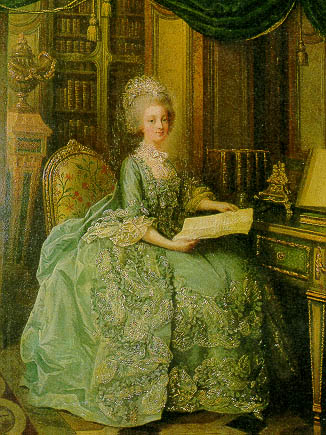
during the period of the French Revolution
which was called "la Terreur",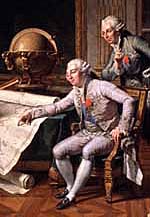
The same thing happened to Marie-Antoinette, his Queen,
and yet he had been beloved by his people.
It was 1774 when LOUIS XV died

Painting of Louis XV
'Protect us, Lord, for we reign too young.' The new king was twenty years old.
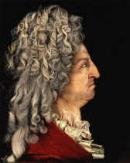
had set a record on the throne, starting his reign at 5 years old (1643-1715) and changed the Monarchy's lifestyle in France, especially with his many Official Mistresses,
Mme de Montespan
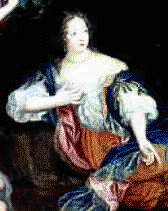
who had several children by him, Mlle de Fontanges, Mme de Maintenon whom he married after Queen Maria-Theresa's death. Louis XIV was also the one who built Versailles, having the marshland reclaimed.
La Galerie des Glaces
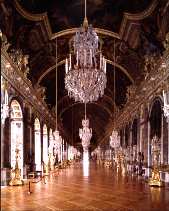
known in English as The Hall of Mirrors.
It was erected to the glory of Louis XIV and is now the chief masterpiece of Versailles. It was begun in 1678 when the chateau became the official residence, disrupting the order of the salons known as the Apartment of the Planets.
On the signing of the Treaty of Nijmegen, which represented the highpoint of his reign, Louis XIV ordered Le Brun to depict his government's accomplishments on the ceiling of the hall.
Le Brun designed thirty compositions, framed by stucco-work, showing the monarch in various guises: Roman emperor, great administrator of the kingdom, and victor over foreign powers.
Marie-Th�r�se d�Espagne (1638-1683)
wife of Louis XIV in 1660
Marie Leszczinska (1703-1768)
wife of Louis XV in 1725
Marie-Antoinette d�Autriche (1755-1793)
wife of Louis XVI in 1770
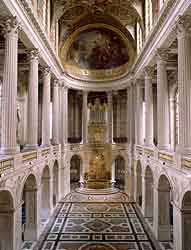
La Chapelle Royale
The Chapel royal of Versailles was consecrated to Saint Louis who was Louis IX, son of Blanche de Castille. The chapel features a tribune overlooking the nave, which is on the same level as the royal apartments.
All three monarchs Louis XIV, Louis XV, and Louis XVI attended daily mass from that tribune, and it was an important moment in a king's day. The courtiers occupied the nave while the ladies were in the lateral galleries.
Members of the Chapel music, renowned throughout Europe, occupied the steps around the organ.
attaining a moment of perfection in the 1750s when
Madame de Pompadour (Jeanne-Antoinette Poisson)
reigned at court as the arbiter of fashion.

Madame de Pompadour belonged to a family of grand Parisian bankers and received a refined education. She soon became known as one of the most beautiful and wittiest women in Paris.
At age 24, she was presented at court, where she became the mistress of Louis XV, who ennobled her as the Marquise de Pompadour. Although she was the focus of the king's passion for only five years, she remained his friend until her death in 1764 at the age of 43. She would have a secret child from the King, raised in Villette. The apartments that the Marquise de Pompadour occupied at Versailles can still be seen today and she remained on good terms with the royal family and displayed respect for the Queen, whose dignity and benevolence made her a great queen.
At age fifteen, Louis XV married Maria Leszczinska, daughter of the king of Poland. 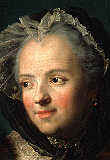
Maria Leszczinska
Before becoming chief architect to Louis XV and friend of Madame de Pompadour, Ange-Jacques Gabriel (1698�1782) trained at Versailles in the school of Hardouin-Mansart, where he learned the monumentality and sobriety that led naturally to his mature style based on the forms and elements of ancient architecture. For 40 years, Gabriel supplied all designs not only for construction projects but also for the constant interior remodeling of Versailles, the Petit Trianon, the Opera, the Gabriel wing, and so on.
see Chateau de Versailles' website at www.chateauversailles.fr/EN/240.asp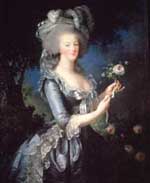
Marie-Antoinette de Hapsbourg-Lorraine
(1755�1793)
France and Austria having settled their differences seven years earlier, in 1770 the heir to the French throne, Louis XV's grandson, married the Austrian archduchess, sealing an alliance that certain people still felt was unnatural. The bride was fifteen years old, the groom sixteen. Their marriage spurred the construction of the Opera, where the wedding festivities were held.
le Dauphin (1781-1789)
The long waiting time for the children, combined with the queen's overly public friendships and youthful heedlessness led to ill will which never abated even when, later, she devoted most of her time to raising her four children- Madame Royale, the first Dauphin, another daughter who died in infancy, and the future Louis XVII (1785-1795). 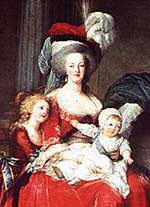
Marie-Antoinette and her children
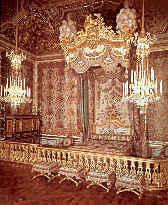
still looks today as it did when Marie-Antoinette left Versailles during the French Revolution in 1789.
The Rococo-style woodwork, as well as the ceiling painting by Fran�ois Boucher (1703�1770) were commissioned around 1730 by Louis XV in order to please his wife, Maria Leszczinska.
* * * * * * * * * *
and Chateau de Versailles' website
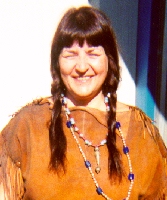
Danielle - Celebrations 2000
* * * * * * * * * * * * * *

Danielle et Olga Obry LeMyre (1916-2006)
Thank you for your visit
Danielle - [email protected] -
514 236-0244

Back to Index
Amerindian, Acadian & European Roots,
a Genealogy & History of 17th & 18th century ancestors:
Tome 1. Nicholas Marsolet
(1587-1677) and others
(Verreau Dupil)
Sign the Guest Book
Please, let us know your own Roots,
we're interested!
(Click here!)
FRANCAIS
(Clicquez ici!)
Click here to send me a private E-MAIL Danielle.
Thank you for your support in coming to my website.
YES, PLEASE LET ME KNOW YOUR OWN ROOTSSignez le nouveau livre de visites
View Guestbook Voir les visites
MERCI, Danielle



Linking the World of Amateur Genealogists
This GenRing site is maintained by the
Webmaster of
" We were there! Quebec, American, Canadian, Amerindian, Acadian & European Roots, a Genealogy & History of Ancestors - Series in 7 tomes"
Danielle Duval LeMyre
@ 2002
CLICK HERE
To order a book of this series